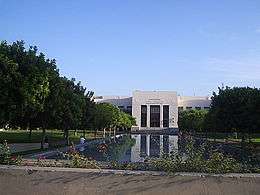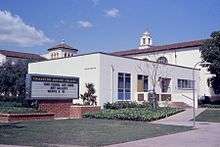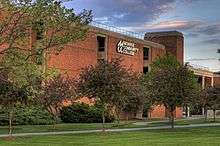Community college

A community college is a type of educational institution. The term can have different meanings in different countries, but usually refers to an educational institution that provides tertiary education and continuing education supplemental to traditional universities and colleges.
Australia
In Australia, the term "community college" is not used. Analogous to community colleges are colleges or institutes of technical and further education (TAFEs); these are institutions mostly regulated at state and territory level. There are also an increasing number of private providers of varying social esteem, which are colloquially called "colleges".
TAFEs and other providers carry on the tradition of adult education, which was established in Australia around mid 19th century when evening classes were held to help adults enhance their numeracy and literacy skills.[1] Most Australian universities can also be traced back to such forerunners, although obtaining a university charter has always changed their nature. In TAFEs and colleges today, courses are designed for personal development of an individual and/or for employment outcomes. Educational programs cover a variety of topics such as arts, languages, business and lifestyle, and are usually timetabled to be conducted in the evenings or weekends to accommodate people working full-time. Funding for colleges may come from government grants and course fees, and many are not-for-profit organisations. There are located in metropolitan, regional and rural locations of Australia.
Learning offered by TAFEs and colleges has changed over the years. By the 1980s many colleges had recognised a community need for computer training and since then thousands of people have been up-skilled through IT courses. The majority of colleges by the late 20th century had also become Registered Training Organisations, recognising the need to offer individuals a nurturing, non-traditional education venue to gain skills that would better prepare them for the workplace and potential job openings.[2] TAFEs and colleges have not traditionally offered bachelor's degrees, instead providing pathway arrangements with universities to continue towards degrees. The American innovation of the associate degree is emerging at some institutions. Certificate courses I to IV, diplomas and advanced diplomas are typically offered, the latter deemed equivalent to an undergraduate qualification, albeit typically in more vocational areas. Recently, some TAFE institutes (and private providers) have also become higher education providers in their own right and are now starting to offer bachelor's degrees programs.
Canada
In Canada, community colleges are adult educational institutions that provide higher education and tertiary education, and grant certificates and diplomas. Each province has its own educational system, as prescribed by the Canadian federalism model of governance. Most Canadian colleges began in the mid-1960s and early 1970s to provide practical education and training for the emerging baby boom generation, and for immigrants from around the world who were entering Canada in increasing numbers at that time. A formative trend was the merging of the then separate vocational training and adult education (night school) institutions.
Canadian colleges are either publicly funded or private post-secondary institutions (run for profit). There are 150 institutions that are generally equivalent to the US community college in certain contexts. They are usually referred to simply as "colleges" since in common usage a degree-granting institution is almost exclusively a university.
In addition to graduate degrees, universities generally grant Associate's degrees and Bachelor's degrees, but in some regions and/or courses of study, colleges and universities collaborate so college students can earn transfer credits toward undergraduate university degrees.
University degrees are usually attained through four years of study. The term associate degree is used in western Canada to refer to a two-year college arts or science degree, similar to how the term is used in the United States. In other parts of Canada the term advanced degree is used to indicate a 3- or 4-year college program.
In the province of Quebec, three years is the norm for a university degree because a year of credit is earned in the CEGEP (college) system. Even when speaking in English, people often refer to all colleges as [3] Cégeps, however the term is an acronym more correctly applied specifically to the French-language public system: Collège d'enseignement général et professionnel (CEGEP); in English: College of General and Vocational Education. The word College can also refer to a private High School in Quebec.
- Canadian community college systems
- List of colleges in Canada
- Colleges and Institutes Canada (CICan)[4] - publicly funded educational institutions; formerly the Association of Canadian Community Colleges (ACCC)
- National Association of Career Colleges[5] - privately funded educational institutions; formerly the Association of Canadian Career Colleges
India
In India, 98 community colleges are recognized by the University Grants Commission. The courses offered by these colleges are diplomas, advance diplomas and certificate courses. The duration of these courses usually ranges from six months to two years.[6]
Malaysia
Community colleges in Malaysia are a network of educational institutions whereby vocational and technical skills training could be provided at all levels for school leavers before they entered the workforce. The community colleges also provide an infrastructure for rural communities to gain skills training through short courses as well as providing access to a post-secondary education.
At the moment, most community colleges award qualifications up to Level 3 in the Malaysian Qualifications Framework (Certificate 3) in both the Skills sector (Sijil Kemahiran Malaysia or the Malaysian Skills Certificate) as well as the Vocational and Training sector but the number of community colleges that are starting to award Level 4 qualifications (Diploma) are increasing. This is two levels below a bachelor's degree (Level 6 in the MQF) and students within the system who intend to further their studies to that level will usually seek entry into Advanced Diploma programs in public universities, polytechnics or accredited private providers.
Philippines
In the Philippines, a community school functions as elementary or secondary school at daytime and towards the end of the day convert into a community college. This type of institution offers night classes under the supervision of the same principal, and the same faculty members who are given part-time college teaching load.[7]
The concept of community college dates back to the time of the former Minister of Education, Culture and Sports (MECS) that had under its wings the Bureaus of Elementary Education, Secondary Education, Higher Education and Vocational-Technical Education. MECS Secretary, Dr. Cecilio Putong, who in 1971 wrote that a community school is a school established in the community, by the community, and for the community itself. Dr. Pedro T. Orata of Pangasinan shared the same idea, hence the establishment of a community college, now called the City College of Urdaneta.[7]
A community college like the one in Abuyog, Leyte can operate with only a PHP 124,000 annual budget in a two-storey structure housing more than 700 students.[7]
United Kingdom (excluding Scotland)
In the United Kingdom, except for Scotland, a community college is a school which not only provides education for the school-age population (11–18) of the locality, but also additional services and education to adults and other members of the community.[8] This education includes but is not limited to sports, adult literacy and lifestyle education. Usually at the age of 16 when students finish their secondary school studies, they move on to a sixth form college where they study for their A-levels (although some secondary schools have integrated sixth forms). After the two-year A-level period, they may then proceed to a college of further education or a university. This is also known as a technical college.
United States


In the United States, community colleges, sometimes called junior colleges, technical colleges, two-year colleges, or city colleges, are primarily two-year public institutions providing higher education and lower-level tertiary education, granting certificates, diplomas, and associate's degrees. Many also offer continuing and adult education. After graduating from a community college, some students transfer to a four-year liberal arts college or university for two to three years to complete a bachelor's degree.
Before the 1970s, community colleges in the United States were more commonly referred to as junior colleges, and that term is still used at some institutions. However, the term "junior college" has evolved to describe private two-year institutions, whereas the term "community college" has evolved to describe publicly funded two-year institutions. The name derives from the fact that community colleges primarily attract and accept students from the local community, and are often supported by local tax revenue.
Research
There are research organizations and publications which focus upon the activities of community college, junior college, and technical college institutions.[9] Many of these institutions and organizations present the most current research and practical outcomes at annual community college conferences.
- The American Association of Community Colleges[10][11] has provided oversight on community college research since the 1920s.[12] AACC publishes a research journal called the Community College Journal.[13]
- The Community College Research Center (CCRC), located at Teachers College, Columbia University, is the leading independent authority on the nation's two-year colleges. CCRC annually publishes numerous papers, reports, briefs, and practitioner packets on issues pertaining to community colleges and open-access four-year colleges to help college and system leaders, administrators, faculty, and support staff improve institutional performance and student success.
- The Association of Community College Trustees (ACCT) has provided education for community college boards of directors and advocacy for community colleges since 1972. ACCT President and CEO J. Noah Brown authored a book about the past, present, and future of community colleges, Charting a New Course for Community Colleges: Aligning Policies with Practice.
- The mission of the Community College Research Center from Teachers College at Columbia University is to "conduct research on the major issues affecting community colleges in the United States and to contribute to the development of practice and policy that expands access to higher education and promotes success for all students."[14]
- The Center for Community College Student Engagement at the University of Texas at Austin administers surveys and provides data analysis support to member colleges regarding various factors of student engagement and involvement in community colleges in the United States and Canada.[15]
- The Office of Community College Research and Leadership at the University of Illinois at Urbana-Champaign studies policies, programs, and practices designed to enhance outcomes for diverse youth and adults who seek to transition to and through college to employment. OCCRL's research spans the P-20 education continuum, with an intense focus on how community colleges impact education and employment outcomes for diverse learners. Results of OCCRL's studies of pathways and programs of study, extending from high school to community colleges and universities and to employment, are disseminated nationally and internationally. Reports and materials are derived from new knowledge captured and disseminated through OCCRL's website, scholarly publications, and other vehicles.[16]
Several peer-reviewed journals extensively publish research on community colleges:
- Community College Journal of Research and Practice
- New Directions for Community Colleges
- Community College Review
- Journal of Applied Research in the Community College
- Journal of Transformative Leadership and Policy Studies
See also
- In Australia
- Technical and further education
- Workers' Educational Association, also in the UK
- In the Philippines
- In the UK
Notes
- ↑ just host. "Welcome ace.nsw.gov.au - Justhost.com".
- ↑ cca.edu.au
- ↑ Quebec Government http://www.immigration-quebec.gouv.qc.ca/en/employment/comparative-evaluation/education-system.html. Retrieved 11 June 2014. Missing or empty
|title=(help) - ↑ Colleges and Institutes Canada (CICan)
- ↑ National Association of Career Colleges
- ↑ "UGC approves 98 community colleges from five states". Retrieved 13 June 2015.
- 1 2 3 Danao, Dr. Carolina P. (2005-02-20). "The medium-term higher education development plan and the local colleges and universities". The Manila Bulletin Online. Archived from the original on 2005-02-20. Retrieved 2008-08-19.
- ↑ "community college meaning in the Cambridge English Dictionary".
- ↑ Mellow, G.O. & Heelan, C. (2008). Minding the Dream: The Process and Practice of the American Community College. New York: Rowman & Littlefield. ISBN 978-0-7425-6292-9
- ↑ Cohen, A.M. & Brawer, F.B. (2008). The American Community College (5th Ed.). San Francisco: Jossey-Bass. ISBN 978-0-470-17468-5
- ↑ Vaughn, G.B. (2000). The Community College Story. Community College Press. ISBN 0-87117-323-9
- ↑ Geller, H.A. (2001). "A brief history of community colleges and a personal view of some issues (open admissions, occupational training and leadership)." http://www.eric.ed.gov/ERICWebPortal/contentdelivery/servlet/ERICServlet?accno=ED459881
- ↑ gseis.ucla.edu
- ↑ "CCRC". Retrieved 13 June 2015.
- ↑ "CCSSE – Community College Survey of Student Engagement". Retrieved 13 June 2015.
- ↑ "Office of Community College Research and Leadership, University of Illinois at Urbana-Champaign". Retrieved 13 June 2015.
References
- Baker, G. A. III (1994). A handbook on the community college in America: Its history, mission, and management. Westport, CT: Greenwood Press.
- Cohen, A.M., Brawer, F.B. (2003) The American Community College, 4th edition. San Francisco: Jossey Bass.
- Dougherty, K. J. (1994). The contradictory college: The conflicting origins, impacts, and futures of the community college. Albany, NY: State University of New York Press.
- Floyd, D.L., Skolnik, M.L., & Walker, K.P., eds. (2005). The Community College Baccalaureate: Emerging Trends and Policy Issues. Sterling VA: Stylus Publishing.
- Frye, J. H. (1992). The vision of the public junior college, 1900–1940. Westport, CT: Greenwood Press.
- Kasper, H.T. (2002). The changing role of community college. Occupational Outlook Quarterly, 46(4), 14–21.
- Murray, J.P. (2002). The current state of faculty development in two-year colleges. New Directions for Community Colleges, 118, 89–97.
- Vaughan, George, Mellander, Gustavo, Beverly Blois (1997). The Community College Presidency. Washington,DC: The American Association of Community Colleges.
External links
- Community Colleges Australia
- Community College Research Center, Teachers College, Columbia University